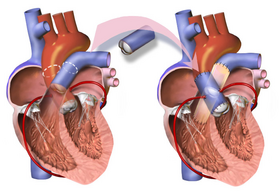| Ross procedure | |
|---|---|
 Ross Procedure | |
| Other names | Pulmonary autograft, switch procedure, double-switch Ross procedure |
| Specialty | Cardiac surgery |
| Uses | Aortic valve disease[1] |
| Approach | Median sternotomy[1] |
| Types | Subcoronary method, root replacement technique[2] |
| Outcomes | Good if performed in specialist centre,[1] 80% to 90% 10 year survival.[3] |
The Ross procedure, also known as pulmonary autograft, is a heart valve replacement operation to treat severe aortic valve disease, such as in children and young adults with a bicuspid aortic valve.[1] It involves removing the diseased aortic valve, situated at the exit of the left side of the heart (where the aorta begins), and replacing it with the person's own healthy pulmonary valve (autograft), removed from the exit of the heart's right side (where the pulmonary artery begins).[4] To reconstruct the right-sided exit, a pulmonary valve from a cadaver (homograft), or a stentless xenograft, is used to replace the removed pulmonary valve.[1][a] Compared to a mechanical valve replacement, it avoids the requirement for thinning the blood, has favourable blood flow dynamics, allows growth of the valve with growth of the child and has less risk of endocarditis.[1]
It is not performed if Marfan syndrome, pulmonary valve disease, or immune problems like lupus are present.[3] Other contraindications include severe coronary artery disease and severe mitral valve disease.[3] Due to a higher chance of dysfunction of the autograft, it may not always be safe to perform in rheumatic valve disease, or if a dysplastic dilated aortic root is present.[6] Complications include endocarditis, degeneration of the valves, aortic dissection, haemorrhage and venous thromboembolism, among others.[1][2] It risks having a disease of two valves instead of one.[7]
The procedure requires technical expertise.[4] It can be performed using the traditional subcoronary method or more commonly the root replacement technique, which requires re-implanting the coronary arteries.[8][9]
After the operation, good blood pressure control prevents early dilatation of the new aortic root and allows the pulmonary autograft, now in the aortic position, to settle in its new environment.[10] It may need reoperating on at a later date.[7] Complications occur in 3 to 5% of cases, with early death rate almost negligible in very experienced centres.[3] 80% to 90% of cases survive 10 years.[3] As of 2014, the Ross procedure comprises less than 1% of all aortic valve replacements in North America.[1]
The procedure was first performed using the subcoronary method in 1967 by Donald Ross, for whom the procedure is named.[8][11] The root replacement method was introduced in the early 1970s.[8] It was continued and modified by others such as Magdi Yacoub, who used fresh valves from the explanted hearts of transplant recipients.[11]
- ^ a b c d e f g h Bouhout, Ismail; Hammamsy, Ismail (2020). "38. The Ross procedure". In Raja, Shahzad G. (ed.). Cardiac Surgery: A Complete Guide. Switzerland: Springer. pp. 351–358. ISBN 978-3-030-24176-6.
- ^ a b Nappi, Francesco; Singh, Sanjeet Singh Avtaar; Bellomo, Francesca; Nappi, Pierluigi; Iervolino, Adelaide; Acar, Christophe (2021). "The Choice of Pulmonary Autograft in Aortic Valve Surgery: A State-of-the-Art Primer". BioMed Research International. 2021: 5547342. doi:10.1155/2021/5547342. ISSN 2314-6141. PMC 8060091. PMID 33937396.
- ^ a b c d e Brown, Kristen N.; Kanmanthareddy, Arun (2022). "Aortic Valve Ross Operation". StatPearls. StatPearls Publishing. PMID 30725934.
- ^ a b Moroi, Morgan K.; Bacha, Emile A.; Kalfa, David M. (2021). "The Ross procedure in children: a systematic review". Annals of Cardiothoracic Surgery. 10 (4): 420–432. doi:10.21037/acs-2020-rp-23. ISSN 2225-319X. PMC 8339620. PMID 34422554.
- ^ Bunce, Nicholas H.; Ray, Robin; Patel, Hitesh (2020). "30. Cardiology". In Feather, Adam; Randall, David; Waterhouse, Mona (eds.). Kumar and Clark's Clinical Medicine (10th ed.). Elsevier. p. 1102. ISBN 978-0-7020-7870-5.
- ^ Morita, K.; Kurosawa, H. (April 2001). "[Indications for and clinical outcome of the Ross procedure: a review]". Nihon Geka Gakkai Zasshi. 102 (4): 330–336. ISSN 0301-4894. PMID 11344686.
- ^ a b Etnel, Jonathan R.G.; Grashuis, Pepijn; Huygens, Simone A.; Pekbay, Begüm; Papageorgiou, Grigorios; Helbing, Willem A.; Roos-Hesselink, Jolien W.; Bogers, Ad J.J.C.; Mokhles, M. Mostafa; Takkenberg, Johanna J.M. (1 December 2018). "The Ross Procedure: A Systematic Review, Meta-Analysis, and Microsimulation". Circulation: Cardiovascular Quality and Outcomes. 11 (12): e004748. doi:10.1161/CIRCOUTCOMES.118.004748. PMID 30562065. S2CID 56477833.
- ^ a b c Van Hoof, Lucas; Verbrugghe, Peter; Jones, Elizabeth A. V.; Humphrey, Jay D.; Janssens, Stefan; Famaey, Nele; Rega, Filip (9 February 2022). "Understanding Pulmonary Autograft Remodeling After the Ross Procedure: Stick to the Facts". Frontiers in Cardiovascular Medicine. 9: 829120. doi:10.3389/fcvm.2022.829120. ISSN 2297-055X. PMC 8865563. PMID 35224059.
- ^ Tweddell, James S. (4 January 2021). "The root replacement remains the gold standard for the Ross procedure". European Journal of Cardio-Thoracic Surgery. 59 (1): 234–235. doi:10.1093/ejcts/ezaa366. ISSN 1873-734X. PMID 33188684.
- ^ Cite error: The named reference
Mazine2018was invoked but never defined (see the help page). - ^ a b Treasure, Tom (2000). "16. Cardiac surgery". In Silverman, Mark E.; Fleming, Peter R.; Hollman, Arthur; Julian, Desmond G.; Krikler, Dennis M. (eds.). British Cardiology in the 20th Century. Springer. p. 206. ISBN 978-1-4471-1199-3.
Cite error: There are <ref group=lower-alpha> tags or {{efn}} templates on this page, but the references will not show without a {{reflist|group=lower-alpha}} template or {{notelist}} template (see the help page).